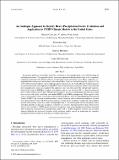An Analogue Approach to Identify Heavy Precipitation Events: Evaluation and Application to CMIP5 Climate Models in the United States
Author(s)
Gao, Xiang; Xie, Pingping; Monier, Erwan; Entekhabi, Dara; Schlosser, Adam
DownloadGao-2014-An Analogue Approach.pdf (5.005Mb)
PUBLISHER_POLICY
Publisher Policy
Article is made available in accordance with the publisher's policy and may be subject to US copyright law. Please refer to the publisher's site for terms of use.
Terms of use
Metadata
Show full item recordAbstract
An analogue method is presented to detect the occurrence of heavy precipitation events without relying on modeled precipitation. The approach is based on using composites to identify distinct large-scale atmospheric conditions associated with widespread heavy precipitation events across local scales. These composites, exemplified in the south-central, midwestern, and western United States, are derived through the analysis of 27-yr (1979–2005) Climate Prediction Center (CPC) gridded station data and the NASA Modern-Era Retrospective Analysis for Research and Applications (MERRA). Circulation features and moisture plumes associated with heavy precipitation events are examined. The analogues are evaluated against the relevant daily meteorological fields from the MERRA reanalysis and achieve a success rate of around 80% in detecting observed heavy events within one or two days. The method also captures the observed interannual variations of seasonal heavy events with higher correlation and smaller RMSE than MERRA precipitation. When applied to the same 27-yr twentieth-century climate model simulations from Phase 5 of the Coupled Model Intercomparison Project (CMIP5), the analogue method produces a more consistent and less uncertain number of seasonal heavy precipitation events with observation as opposed to using model-simulated precipitation. The analogue method also performs better than model-based precipitation in characterizing the statistics (minimum, lower and upper quartile, median, and maximum) of year-to-year seasonal heavy precipitation days. These results indicate the capability of CMIP5 models to realistically simulate large-scale atmospheric conditions associated with widespread local-scale heavy precipitation events with a credible frequency. Overall, the presented analyses highlight the improved diagnoses of the analogue method against an evaluation that considers modeled precipitation alone to assess heavy precipitation frequency.
Date issued
2014-12Department
Massachusetts Institute of Technology. Center for Global Change Science; Massachusetts Institute of Technology. Department of Civil and Environmental Engineering; Massachusetts Institute of Technology. Joint Program on the Science & Policy of Global ChangeJournal
Journal of Climate
Publisher
American Meteorological Society
Citation
Gao, Xiang, C. Adam Schlosser, Pingping Xie, Erwan Monier, and Dara Entekhabi. “An Analogue Approach to Identify Heavy Precipitation Events: Evaluation and Application to CMIP5 Climate Models in the United States.” J. Climate 27, no. 15 (August 2014): 5941–5963. © 2014 American Meteorological Society
Version: Final published version
ISSN
0894-8755
1520-0442